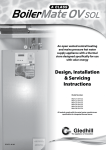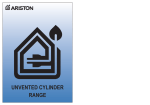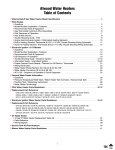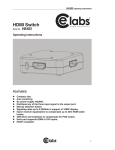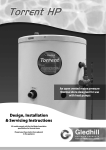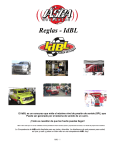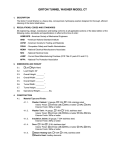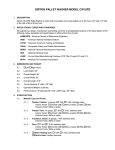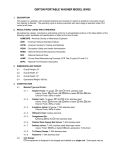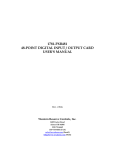Download Viessmann Vitocell 200 Cylinder Technical data
Transcript
Design, Installation, User & Servicing Instructions An unvented hot water storage appliance complying with the requirements of Building Regulations Approved Document G3 and manufactured in accordance with BS EN 12897, the specification for unvented water storage vessels. in the interest of continuously improving the Vitocell 200 Cylinder range, Viessmann reserve the right to modify the product without notice, and in these circumstances this booklet, which is accurate at the time of printing, should be disregarded. CONTENTS These instructions should be read in conjunction with the installation/servicing instructions issued by the manufacturer of the heat source being used. Any installation must be in accordance with the relevant requirements of the Gas Safety Regulations, Building Regulations, I.E.E. Wiring Regulations and the Water Fitting Regulations (England and Wales) or Water Byelaws (Scotland). It should be read in accordance with the relevant recommendations of the following: BS 6798; BS 5549; BS 5546; BS 5440:1; BS 5440:2; CP 331:3 BS 6700: BS 5258 and BS 7593: 1992 ISSUE 4.11: 04-10 Section Page DESIGN Description Technical Data System Details 3 6 8 Viessmann Vitocell 200 Cylinder is covered by Section G3 of the Building Regulations (England and Wales) Technical Standard P3 (Scotland) and Building Regulation P5 (Northern Ireland. Compliance can be achieved via a Competent Person Self Certification Scheme or notificaton of installation to the Local Authority Building Control Department. INSTALLATION Installation Commissioning 10 20 It must be installed by a competent person as defined by the relevant regulations. Manufacturers notes must NOT be taken as over-riding statutory obligations. USER INSTRUCTIONS 21 SERVICING Servicing and Maintenance Fault Finding Spare Parts List 22 23 26 ADDENDIX Addendix A Addendix B 27 28 This appliance is not intended for use by persons (including children) with reduced physical, sensory or mental capabilities, or lack of experience and knowledge unless they have been given supervision or instruction concerning use of the appliance by a person responsible for their safety. Children should be supervised at all times to ensure they do not play with the appliance. This information is provided to assist generally in the selection of equipment. Responsibility for selection and specification of our equipment must however remain that of our customer and any experts or consultants concerned with the installation(s). Please note: that we do not therefore accept any responsibility for matters of design selection or specification, for the effectiveness of an installation or system containing one of our products unless specifically requested to do so in writing. All goods are sold subject to our conditions of sale which are set out at the rear of this specification. In the interest of continuously improving the Viessmann Vitocell 200 Cylinder range, Viessmann Limited reserve the right to modify the product without notice, and in these circumstances this booklet, which is accurate at the time of printing, should be disregarded. An updated set of instructions will be produced and supplied with new appliances and will be made available for other appliances on request. A KIWA PRODUCT APPROVED TO COMPLY WITH ALL RELEVANT PARTS OF THE BUILDING REGULATIONS AND WATER SUPPLY (WATER FITTINGS) REGULATIONS. VIESSMANN VITOCELL 200 CYLINDER IS PRODUCED UNDER AN ISO 9001:2000 QUALITY MANAGEMENT SYSTEM APPROVED BY BSI. As part of the industry wide “benchmark” initiative all Viessmann Vitocell 200 Cylinder appliances now include a Benchmark Installation, Commissioning and Service Record Log Book. Please read carefully and complete all sections relevant to the appliance installation. Carrying out the work required and completing the Log Book will satisfy the requirements of the Building Regulations for commissioning as set out in the Domestic Heating Compliance Guide. The details of the Log Book will be required in the event of any warranty work being required. There is also a section to be completed after each regular service visit. The completed Log Book and these instructions should be left with the cylinder. Page 2 DESIGN Maintenance Supplied By: Viessmann Ltd Maximum inlet pressure to Pressure reducing valve Operating pressure (PRV setting) Expansion vessel charge pressure Expansion relief valve setting Opening pressure of P & T Relief Valve Opening temperature of P & T Relief Valve Energy cut-out thermostat setting Max. working pressure - Primary heat exchanger (Indirect models) Max. working pressure - Solar heat exchanger (Solar models) Immersion heater rating 12 bar 3 bar 3 bar 4.75 bar 6 bar 95°C 80°C 6 bar 10 bar 3kW, 240V AC All cylinders are manufactured in accordance with the requirements of BS EN 12897 The tundish must be positioned so that it is visible to the occupant and is away from electrical devices. Components supplied with Stainless Lite: • Cold water inlet PRV combination valve/expansion relief • Pressure and temperature relief valve • Control thermostat • Energy cut-out thermostat • Energy cut-out motorised valve (indirects only) • Tundish • 3kW Immersion heater • Expansion vessel/mounting bracket/flexible hose • Technical/user product literature (Note: Please refer to tables 1 and 2 on pages 6-9 to confirm the quantity of immersion heaters supplied with the unit) In any situation where the volume of heated pipework (eg. secondary circulation pipes or manifold pipework for multiple units) exceeds 10 litres, then an additional expansion vessel must be fitted to accommodate the extra expansion volume. Handling Before Installation Viessmann Vitocell 200 Cylinder must be handled with care and stored the correct way up in a dry place. Any manual handling/lifting operations will need to comply with the requirements of the Manual Handling Operations Regulations issued by the H.S.E. The appliance can be moved using a sack truck on the rear face although care should be taken and the route should be even. In apartment buildings containing a number of storeys we would recommend that the appliances are moved vertically in a mechanical lift. If it is proposed to use a crane, expert advice should be obtained regarding the need for slings, lifting beams etc. It is essential that these checks be carried out at the time of boiler maintenance by a qualified installer: 1. Manually open the relief valves in turn, and check that water is discharged from the valves and runs freely through the tundish and out at the discharge point. Ensure that the valves re-seat satisfactorily. (Note - the water may be very hot). 2. It is important to check that the discharge pipework is carrying the water away adequately. Check for blockages etc. if it is not. 3. Turn the mains water off and remove and clean the strainer element in the Pressure Reducing Valve. 4. Check the charge pressure in the expansion vessel and repressurise if required 5. Re-fill the system and ensure that all relief valves have re-seated. 6. The Benchmark log book supplied should be updated at each service. 7. Check the water pressure downstream of the combination valve is 3 bar in static condition. 8. Check and if necessary, descale the heat exchanger in hard water areas ie. above 200ppm (mg/l). Note: The cylinder is factory fitted with a temperature & pressure relief valve that must not be used for any other purpose or removed. The cylinder is factory fitted with immersion heaters with thermal cut outs. Immersions without thermal cut outs must not be fitted. DESCRIPTION A specific manual handling assessment is shown in Appendix B at the rear of this manual. Modifications should not be made to this product. Replacement parts, including immersion heaters, should be purchased from Viessmann Limited, or agents approved by them. Unvented hot water storage vessels need regular routine checks, and these are detailed below. It is for this reason that this manual must always be left with the Viessmann Vitocell 200 Cylinder. Page 3 DESIGN Figure 1 Introduction Viessmann Vitocell 200 Cylinder is a range of unvented hot water storage cylinders, manufactured in the latest high quality duplex stainless steel. They are designed to provide mains pressure hot water and are supplied as a package which complies with Section G3 of the Building Regulations. The appliance is extremely well insulated using high density HCFC free foam insulation with an ozone depleting potential (ODP) of zero and a global warming potential (GWP) of 1. It is fitted with all necessary safety devices and supplied with all the necessary control devices to make installation on site as easy as possible. Viessmann Vitocell 200 Cylinder is available in two basic variants: 1. Viessmann Vitocell 200-V Cylinder - For use with gas or oil boilers (Figure 1). Vitocell 200 Cylinders must not be used with solid fuel boilers or steam as the energy source. 2. Viessmann Vitocell 200-B Solar Cylinder - For providing hot water by solar gains and gas or oil boilers (Figure 2). Unvented cylinders must not be used with solid fuel boilers or steam as the energy source. Viessmann Vitocell 200-V Cylinder Pipework is not supplied by manufacturer, but to be supplied and fitted by installer. Viessmann Vitocell 200-V Cylinder Viessmann Vitocell 200-V Cylinder is an unvented hot water storage cylinder and is provided with a high efficiency internal primary coil which is designed for use with a gas or oil boiler and is suitable for both open vented and sealed pumped primary systems. When used with a sealed heating system the boiler must incorporate its own energy cut-out overheat thermostat. DESCRIPTION Viessmann Vitocell 200-V Cylinder models are listed in Table 1 on Page 6 & 7. Page 4 DESIGN Viessmann Vitocell 200-B Solar Cylinder Viessmann Vitocell 200-B Solar Cylinder is an unvented hot water storage cylinder and is provided with a high efficiency internal primary coil which is designed for use with a gas or oil boiler and is suitable for both open vented and sealed pumped primary systems. Figure 2 When used with a sealed heating system the boiler must incorporate its own energy cut-out overheat thermostat. A high efficiency second solar coil is positioned below the primary coil to ensure maximum benefit of solar gain energy. Viessmann Vitocell 200-B Solar Cylinder models are listed in Table 1 on Page 6 & 7. Note: The cold supply elbow c/w drain tapping must be fitted as shown in figs 1, 2, 3 and 4. A flexible hose can then be connected to the drain tapping and, providing the hose runs below the lowest level of the cylinder, then all the water contents can be drained out by syphonic action. Viessmann Vitocell 200-B Solar Cylinder DESCRIPTION Pipework is not supplied by manufacturer, but to be supplied and fitted by installer. Page 5 DESIGN Vitocell 200-V C J F I K I P E M L E H F J G D G N C B B A A Vitocell 200-B Solar 12 732 550 490 n/a 352 367 n/a 40 367 120 22 142 120 3 12 920 550 678 n/a 352 367 n/a 67 367 150 26 176 150 3 18 1107 550 865 n/a 392 442 n/a 92 407 180 28 208 180 3 18 1295 550 1053 n/a 432 442 n/a 116 447 210 33 243 210 3 24 1483 550 1241 1127 432 442 n/a 145 482 250 38 288 250 3 24 1733 550 1491 1377 927 522 512 109 577 300 44 344 300 3 35 2020 550 1777 1577 1242 522 512 130 677 210 35 245 210 3 24 1483 550 1241 1127 822 437 n/a 95 837 250 40 290 250 3 24 1733 550 1491 1377 947 522 n/a 115 962 300 46 346 300 3 35 2020 550 1777 1577 1042 522 n/a 140 1092 Overall Height Dual Control & Overheat Stat 3 Volume of On Peak Water Heated 90 Off Peak Immersion Heater - Low Level 109 Cold Feed 22mm Compression Connection 19 mm On Peak Immersion Heater - High Level 90 Litres A=mm 22mm Secondary Return Tapping bar Pressure & Temperature Relief Valve 6bar 95°C Pressure Regulator 3 bar inlet group c/w balance cold supply, expansion vessel connection and expansion valve set at 4.75 bar Litres Overall Diameter Capacity (Total Volume) kg Expansion Vessel size. Pre-charged to 3 bar Weight - Full kg Model Weight - Empty Table 1 B=mm C=mm D=mm E=mm F=mm Litres G=mm TECHNICAL DATA Vitocell 200-V Vitocell 200-B Solar Page 6 DESIGN NOTES 1. Not all models - see table 1. 2. Recovery times based on Primary Coil/I.H. duty (ie. assumes the boiler output is adequate). 3. All connections are supplied with compression fittings for direct connection to copper pipework. 15,00º 0º 35,0 Pressure Loss Across Primary Heater Coil Surface Area of Solar Heater Coil Pressure Loss Across Solar Heater Coil Heat Up Time from 15°C to 60°C (applies to Primary Heat Source only) Recovery Time after 70% Draw Off (applies to Primary Heat Source only) Standing Losses kWhr/24hr Dedicated Solar Volume H=mm I=mm J=mm K=mm L=mm M=mm N=mm P=mm 0º Surface Area of Primary Heater Coil Solar Pocket 0 45, Solar Pocket Dual Control & Overheat Stat 22mm Solar Flow Compression Connection 22mm Solar Return Compression Connection 22mm Primary Flow Compression Connection 22mm Primary Return Compression Connection Extra Stat Pocket For Boiler Use If Required 40,0 0º kW m2 bar m2 bar min min kWh Litres 367 223 312 n/a n/a n/a n/a n/a 16.5 0.59 0.165 n/a n/a 21 16 0.80 n/a 367 223 312 n/a n/a n/a n/a n/a 18 0.59 0.165 n/a n/a 27 19 1.00 n/a 407 223 392 n/a n/a n/a n/a n/a 18.5 0.68 0.191 n/a n/a 28 19 1.20 n/a 447 223 392 n/a n/a n/a n/a n/a 19 0.78 0.216 n/a n/a 33 21 1.40 n/a 482 223 392 n/a n/a n/a n/a n/a 20.5 0.78 0.216 n/a n/a 41 26 1.60 n/a 577 223 472 n/a n/a n/a n/a n/a 21.5 0.97 0.241 n/a n/a 44 30 1.75 n/a 677 223 522 n/a n/a n/a n/a n/a 25 0.97 0.241 n/a n/a 48 32 1.93 n/a n/a 522 782 223 352 419 1000 203 18.5 0.68 0.191 0.680 0.191 35 16 1.60 70 n/a 607 907 223 472 539 1180 262 19 0.78 0.216 0.970 0.241 38 19 1.75 84 n/a 702 1002 223 472 539 1367 262 20.5 0.78 0.216 0.970 0.241 41 20 1.93 100 Page 7 TECHNICAL DATA º kW Rating of Primary Coil 25,00 DESIGN Viessmann Vitocell 200-V Cylinder 1 Basic Appliance 1. Hot water draw off (22mm) compression 2. Temperature & pressure relief valve 95°/6 bar 3. Hot water secondary return 22mm (not fitted to smaller sizes, see table 1) 4. Immersion heater 1¾” BSP 3kW 5. 22mm cold supply compression 6. Immersion heater 1¾” BSP 3kW 7. Dual control/overheat stat pocket (22mm) 8. Boiler control sensor pocket (spare) 9. Primary return (22mm) 10. Primary flow (22mm)) 2 3 4 7 8 6 Component kit supplied separately A. Combination inlet group incorporating pressure reducing valve, strainer, check valve, balance cold take off point, expansion relief valve and expansion vessel connection points. B. Potable expansion vessels c/w flexible hose and wall bracket C. Tundish D. Dual control thermostat and combined overheat thermostat E. Two port (22mm) zone valve for primary circuit F. Wiring junction box for primary system 5 10 9 SYSTEM DETAILS Typical arrangement of component kit shown fitted to the appliance for clarity Pipework to be supplied and fitted by installer. Page 8 DESIGN 1 2 3 12 9 7 6 11 12 4 8 5 10 Basic Appliance 1. Hot water draw off (22mm) compression 2. Temperature & pressure relief valve 95°/6 bar 3. Hot water secondary return 22mm (not fitted to smaller sizes, see table 1) 4. Immersion heater 1¾” BSP 3kW 5. 22mm cold supply 6. Dual control/Overheat stat pocket 7. Primary return (22mm) 8. Primary flow (22mm) 9. Dual control/Overheat stat pocket 10. Solar coil return to panel collector (22mm) compression 11. Solar coil flow from panel (22mm) compression 12. Solar thermostat pocket Component kit supplied separately A. Combination inlet group incorporating pressure reducing valve, strainer, check valve, balance cold take off point, expansion relief valve and expansion vessel connection points. B. Potable expansion vessels c/w flexible hose and wall bracket C. Tundish D. Dual control thermostat and combined overheat thermostat (x2) E. Two port (22mm) zone valve for primary circuit F. Wiring junction box for primary system SYSTEM DETAILS Typical arrangement of component kit shown fitted to the appliance for clarity Pipework to be supplied and fitted by installer. Viessmann Vitocell 200-B Solar Cylinder Page 9 INSTALLATION General Design Considerations The cupboard footprint needs to be at least 650mm square for units up to 300 litres and 730mm for 400 litre. The base chosen for the cylinder should be level and capable of supporting the weight of the unit when full of water as shown in General Data. The discharge pipework for the safety valves must have a minimum fall of 1 : 200 from the unit to a safe discharge point. All exposed pipework should be insulated and the unit should NOT be fixed in a location where the contents could freeze. The pipe connecting the boiler flow to the appliance must not be less than 22mm copper or equivalent. Combination Valve I.V. I.V. Mains Water Supply If two Viessmann Vitocell 200 Cylinders are coupled together the secondary inlet and outlet pipes must be balanced. The units must be fitted on the same level. Note: No valves must be fitted between the expansion vessel and the storage cylinder(s). INSTALLATION Model Selection Guide Max hot water demand Max number of bed spaces (Bedrooms) 1 shower room Bedsit (0) 90 1 bathroom 2 (2) 120 1 bathroom 4 (3) 120 1 bathroom + separate shower room 6 (4) 150 1 bathroom + 2 separate shower rooms or 2 bathrooms 7 (5) 180 2 bathrooms + separate shower room 7 (5) 210 2 bathrooms + 2 separate shower rooms 7 (5) 250 3 bathrooms + 2 separate showers rooms 9 (6) 300 Litres Solar Model Selection Guide Max hot water demand Max floor area (m2) Bedrooms Litres 1 bathroom + 1 shower room 66 1-3 210 1 bathroom + 2 shower rooms 84 2-4 250 2 bathrooms + 1 shower room 113 3-4 300 Page 10 Existing properties with a 15mm supply will be satisfactory provided the local mains pressure is good, but should be confined to single bathroom properties. For new properties where simultaneous demand is required to more than one bathroom or a bathroom and one or more en-suites, the communication and service pipe into the dwelling should be a minimum of 22mm (usually in the form of a 25mm MDPE supply). The minimum recommended static pressure to operate a Viessmann Vitocell 200 Cylinder domestic system is 3 bar. There should be a flow of at least 30 litres per minute or above available into the property. Normally Viessmann Vitocell 200 Cylinder provides well in excess of 40 litres/min in most conditions. Flow rates for ALL mains pressure systems are subject to district pressures and system dynamic loss. Particularly on larger properties with more than one bathroom, the pipe sizes should be calculated in accordance with BS6700. Model Selection Where selecting a solar model, it is important to check the dedicated solar volume (shown in tables 1 & 2) is suitable for the total floor area of the dwelling to ensure compliance with Building Regulations.The maximum floor area of the dwelling permitted for the models is shown opposite. The suggested model sizes are based on typical hot water usage. For high specification dwellings an increase of one model size should be considered. INSTALLATION General Restrictions Pipe Layout a. The highest hot or cold water draw off point should not exceed 10 metres above the Pressure Reducing Valve. b. An ascending spray type bidet or any other appliance with a Class 1 back-syphonage risk requiring a type A air gap should not be used. c. Viessmann Vitocell 200 Cylinder should not be used where steam is the primary heating medium, or in a situation where maintenance is likely to be neglected. d. Unvented cylinders are not suitable for use with solid fuel boilers. e. If the supply to the mixer fittings (other than a dual outlet type) is not taken from the balanced supply the system will become over pressurized and cause the pressure relief valve to discharge. Over time this could also cause the premature failure of the appliance itself which will not be covered by the warranty, f. In larger properties with a number of bathrooms/en-suites and long pipe runs we would recommend that the balanced cold supply is provided with its own pressure reducing valve and is not taken from the balanced cold connection on the combination valve. In this case it will also be necessary to fit a small expansion vessel on the balanced cold water system to accommodate the pressure rise caused by the increase in temperature of the balanced cold water. g. Check the performance requirements of the terminal fittings with regard to flow/ pressure are suitable. In all mains pressure installations it is important to remember that the incoming cold supply must be shared between all terminal fittings. It is important that a 22mm supply is brought to the appliance and a 22mm take-off is continued at least to the bath. If there are two baths, 28mm pipework should be considered. One metre of smaller diameter pipework, or flow restrictors, should be provided on the final connection to all outlets so as to balance the water available. In any event the distribution pipework should generally be in accordance with EN806:1. Shower Fittings Plastic Pipework This appliance is suitable for use with plastic pipework as long as the material is recommended for the purpose by the manufacturer and is installed fully in accordance with their recommendations. Secondary Hot Water Circulation Aerated taps are recommended to prevent splashing. Any type of shower mixing valve can be used as long as both the hot and cold supplies are mains fed. However, all mains pressure systems are subject to dynamic changes particularly when other hot and cold taps/showers are opened and closed, which will cause changes in the water temperature at mixed water outlets such as showers. For this reason and because these are now no more expensive than a manual shower we strongly recommend the use of thermostatic showers with this appliance. These must be used in 3 storey properties where the impact on pressure/temperature of opening another tap in the system is greater than normal. The shower head provided must also be suitable for mains pressure supplies. Some models are fitted with a secondary return tapping as standard (see table 1 for details). If fitted, an extra expansion vessel may be necessary. A non-return valve MUST be FITTED near the return connection. No valve or terminal fitting should be installed between the non return valve and the cylinder. (See schematic arrangement on page 13.) DHW SH P&T WHB WC ERV/NRV PRV SCV SCV BATH Note: Cold supplies to single taps must be taken from the mains cold water system. Cold supplies to mixer taps must be taken from the balanced cold water connection on the combination valve. WM or DWM W.C. DCV DC DC M DC WATER SOFTENER (IF NECESSARY) INCOMING COLD SUPPLY Page 11 DC INSTALLATION WHB SINK TO EXTERNAL TAP DC INSTALLATION Pressure & Temperature/expansion Relief Valve Pipework Typical Discharge Pipe Arrangement 15 mm discharge pipe Expansion relief valve The relief valve should be installed to discharge in accordance with G3 of the Approved Document of the Building Regulations and should be piped to where it is visible, but will not cause danger to persons or damage to materials. 500 mm max. P&T Relief Valve Dotted line showing alternative route with single tundish being used 300 mm min. 22 mm metal pipe with continuous fall up to 9m equivalent length (D2). Discharge below fixed grating NOTES: Fixed Grating The discharge will consist of scalding water and steam. Asphalt, roofing felt and non-metallic rainwater goods may be damaged by such discharges. The two safety valves will only discharge water under fault conditions. When operating normally water will not be discharged. It is not acceptable to discharge straight into a soil pipe. Trapped gully WORKED EXAMPLE Locations to be avoided when siting a discharge pipe at high level: The example is pipe for G1/2 1. Thebelow discharge shouldtemperature not be located relief valve with a discharge pipe (D2) above a and pedestrian area, above a window, having 4 elbows length ofor7m from the tundish to the point of discharge. door, ventilator etc. Subsequent freezing of the discharge From 2.the table below: should not create a hazard to persons about the building. Maximum resistance allowed for a straight length of 22mm copper discharge pipe 3. aThe adjacent structure should impervious (D2) from G1/2 temperature reliefbe valve is: 9m subtract the resistance for 4 x 22mm x= dia. of discharge to water at 80ºC. pipe elbows at 0.8m each = 3.2m. Therefore the maximum permitted length equates to: 5.8m. 5.8m is less than the actual length of 7m therefore calculate the next largest size. Maximum resistance allowed for a straight length of 28mm pipe (D2) from a G1/2 temperature relief valve equates to: 14m. As the actual length is 7m, a 28mm (D2) copper pipe will be satisfactory. Sizing of copper discharge pipe ‘D2’ for a temperature relief valve with a G1/2 outlet size (as supplied) INSTALLATION The following information is taken from Approved Document G3 of the Building Regulations and is provided to assist with the design and installation of the discharge pipework. However, the information is not exhaustive and reference should always be made to Approved Document G3 of the Building Regulations. The final decision regarding any arrangements rests with Building Control and it is recommended that their advice is sought if you have any concerns regarding this aspect of the installation. Size of discharge pipework Maximum length of straight pipe (no bends or elbows) Deduct the figure below from the maximum length for each bend or elbow in the discharge pipe 22mm Up to 9m 0.8m 28mm Up to 18m 1m 35mm Up to 27m 1.4m The tundish should be vertical, located in the same space as the unvented hot water storage system and be fitted as close as possible and within 500mm of the safety device e.g. the temperature relief valve. The discharge pipe (D2) from the tundish should terminate in a safe place where there is no risk to persons in the vicinity of the discharge, be of metal and: a) Be at least one pipe size larger than the nominal outlet size of the safety device unless its total equivalent hydraulic resistance exceeds that of a straight pipe 9m long i.e. discharge pipes between 9m and 18m equivalent resistance length should be at least two sizes larger than the nominal outlet size of the safety device, between 18 and 27m at least 3 sizes larger, and so on. Bends must be taken into account in calculating the flow resistance. Refer to the table and the worked example. An alter native approach for sizing discharge pipes would be to follow BS6700 Specification for design installation, testing and maintenance of services supplying water for domestic use within buildings and their curtilages. b) Have a vertical section of pipe at least 300mm long, below the tundish before any elbows or bends in the pipe work. c) Be installed with a continuous fall. Page 12 INSTALLATION d) It is preferable for the discharge to be visible at both the tundish and the final point of discharge but where this is not possible or practically difficult there should be clear visibility at one or other of these locations. Examples of acceptable discharge arrangements are: 1. Ideally below the fixed grating and above the water seal in a trapped gulley. 2. Downward discharges at a low level; i.e. up to 100mm above external surfaces such as car parks, hard standings, grassed areas etc are acceptable providing that where children play or otherwise come into contact with discharges, a wire cage or similar guard is positioned to prevent contact whilst maintaining visibility. 3. Discharges at a high level; e.g. into metal hopper and metal down pipe with the end of the discharge pipe clearly visible (tundish visible or not) or onto a roof capable of withstanding high temperature discharges of water and 3m from any plastic guttering systems that would collect such discharges. 4. Where a single pipe serves a number of discharges, such as in blocks of flats, the number served should be limited to not more than 6 systems so that any installation can be traced reasonably easily. The single common discharge pipe should be at least one pipe size larger than the largest individual discharge pipe to be connected. If unvented hot water storage systems are installed where discharges form safety devices may not be apparent i.e. in dwellings occupied by blind, infirm or disabled people, consideration should be given to the installation of an electronically operated device to warn when discharge takes place. Safety The safety devices supplied or fitted on an Viessmann Vitocell 200 Cylinder are selected for their suitability for the temperatures and pressures involved. They must not be changed, removed or by-passed and it is essential that only genuine replacement parts supplied or approved by Viessmann Limited are used. This includes the immersion heaters, which must incorporate an energy cut-out. All parts are available to approved installers from Viessmann Limited. Combination Inlet Group Schematic Diagram Combines elements 1, 2 and 3 below. Hot Outlet Secondary Return Circuit 1. Pressure Reducing Valve - This must be fixed near the cylinder. The cold water supply to any mixer taps/showers must be taken from the cold water tapping of this valve to ensure balanced hot and cold pressures. This valve is factory set to ensure the correct operating pressure for the Viessmann Vitocell 200 Cylinder. Tundish Pump Non Return Valve To Drain Stop Tap Balanced Cold Outlets Immersion Heater ERV Boiler Flow Kitchen Cold Tap Expansion Vessel NRV 2 Port Valve PRV Boiler Return Combination Valve Page 13 2. Non Return Valve - This is integral with the pressure reducing valve to prevent backflow of hot water towards cold water draw off points. 3. Cold Water Expansion Relief Valve - This safety device is preset at the factory and will relieve excess cold water pressure resulting from a fault condition. INSTALLATION P&T Relief Valve INSTALLATION Temperature/Pressure Relief Valve This safety device is also pre-set at the factory and relieves before the temperature reaches 100°C. It is also a Pressure Relief Valve, and is pre-set to 6 bar. E L Thermostat N Immersion Heaters These are 3kW 240V AC heaters and incorporate a thermostat and a manually reset energy cut-out which operates at 80°C. They have incalloy elements to prolong their life expectancy in aggressive water conditions. Please refer to table 1 to clarify how many off peak and on peak immersions are included with the unit you require. Where it is intended that units are fitted to offpeak circuits, then suitable controllers such as the Horstmann off peak electric time controller will be required. External wiring to the immersion heaters must be in accordance with the relevant IEE Wiring Regulations and the circuit must be protected by a suitable fuse and a double pole isolating switch. The correct method of terminating the wiring to the immersion heater is shown opposite. Line Strainer This is integral within the combination inlet group to reduce the likelihood of contaminants fouling the valve seat. Following installation this line strainer must be cleaned and replaced. This needs to be carried out on a regular basis. as part of the annual maintenance/service check. Tundish This is to allow the discharge from any Relief Valve to be seen. It must be fitted away from any electrical devices. See page 12 for discharge pipework details. Safety The immersion heaters must be earthed and they must be isolated from the mains before the cover is removed on every occasion. Replacement immersion heaters should be obtained from Viessmann Limited. Control/Overheat Dual Thermostats INSTALLATION Care must be taken to ensure that the solar probes are fully inserted into the pockets provided. Page 14 Safety Cut-out Immersion Heater Wiring INSTALLATION Schematic Open Vented Primary System Heating/primary Systems The boiler and primary/heating systems should be sized and installed in accordance with BS 5449. Warming/Overflow Pipe F & E Cistern Safety Viessmann Vitocell 200 Cylinder is fitted with a Combined Temperature/Pressure Relief Valve to cope with any increase in system temperature and pressure above the design limitations, when used with boilers up to 45kW output, which is the maximum allowed by section G3 of the Building Regulations. The primary water temperatures should be controlled as outlined below. Motorised Valve (Energy cut-out) Minimum distance as required by boiler manufacturers instructions Motorised Valve Pump 150mm max. Primary Circuit Boiler It is essential that the circuit between the boiler and the Viessmann Vitocell 200 Cylinder is pumped. The motorised zone valve supplied should be fitted adjacent to the unit and controlled by the cylinder thermostat supplied. The thermostat and motorised valve must be wired so that they both switch off should an overheat situation develop. It is important to follow the wiring diagram in the Wiring Section of these instructions. Schematic Sealed Primary System Motorised Valve (Energy cut-out) Sealed Primary Circuit Any boiler used must be fitted with an over temperature cut-out. Unvented primary circuits may be filled or replenished by means of a temporary connection between the circuit and a supply pipe provided a ‘Listed’ double check valve or some other no less effective backflow prevention device is permanently connected at the inlet to the circuit and the temporary connection is removed after use. Alternatively, a CA device can be used, which will allow the system to be permanently connected to the cold mains supply. The primary system can then be topped up, when required, in the same way as an open vented system fitted with an F&E Cistern. Expansion Vessel Safety Valve Gauge Motorised Valve Pump Boiler Viessmann 4-pipe System 4-Pipe System Note Energy cutout devices fitted in the Viessmann boiler The Viessmann Vitodens system boilers are operating on sealed primary circuit and are factory fitted with an integral diverter valve, PRV and expansion vessel and suitable energy cut-out device to comply with G3 requirements. If any Vitodens system boiler is installed with a Vitocell 200, an additional DHW cylinder sensor kit (7179 114) is required. Boiler Page 15 INSTALLATION If the Vitocell 200 is installed with a Viessmann Vitodens condensing system boiler then it is recommended to install the system to a 4-pipe system as shown in the diagram opposite. INSTALLATION Schematic Solar System With Viessmann Boiler As Solar Controller Solar Panel A typical arrangement of a solar system incorporating a Viessmann Vitocell 200-B Solar Cylinder appliance is shown opposite. All components in a solar primary system must be marked or identifiable in such a way that their design pressure and temperature can be readily determined. Note Energy cutout devices fitted in the Viessmann boiler Solar Controller Expansion Vessel Solar Pumping Station A safety device (pressure relief valve) to control the risk of over-pressure in system components should be fitted. A termination from a safety pressure device should minimise the risk of damage to persons or materials. Suitable locations are a high temperature receptacle, in internal gully or else issue externally at ground level. High level termination from walls or on roofs could cause injury to people or animals below if the valve were to release scalding water and steam. The pipe leading to the safety device and the collector should be of rigid and non-deformable construction, without any possibility of restriction or disclosure by any other fitted component. A more detailed diagram of our recommended arrangement for a typical solar system is shown on page 18. The Viessmann solar controller ‘Solar Divicion’ complies with notes a, b and c listed below and therefore a motorised valve is not required in the solar circuit. The solar pocket provided accommodates an 8mm diameter sensor which, with the sensor located in the solar collector (or in the flow pipe immediately adjacent to the collector), will provide the information required by the Vitosolic 100 controller. Note: The motorised valve can be omitted provided that: a) the solar collector is wholly above the cylinder b) the manual RESET high limit thermostat acts directly onto the pump c) check valves are present on both flow and return to prevent gravity circulation INSTALLATION Solar systems designed and installed according to Viessmann instructions will conform with the above. Page 16 INSTALLATION Mixed HW out Mains CW in Figure 2: Cold port of the blending valve connected to balanced cold supply - NON-RETURN VALVE MUST BE FITTED Mixed HW out Non-Return Valve (must be fitted) Mains CW in Figure 3: Cold port of the blending valve connected to mains supply to the vessel after the inlet control group Mixed HW out Mains CW in Page 17 Fitting Blending Valves To The Unvented Viessmann Vitocell Appliances When fitting a blending valve to the unvented appliances, it is important that the installation does not contravene the G3, WRC and Health and Safety directives or the manufacturers recommendations. If this is the case, then the warranty should be null & void. The key requirements to comply with these regulations are: 1. Any fitting or material in contact with potable water (e.g. a blending valve) must be approved by WRC or an equivalent body. 2. Connections or wiring arrangements must not bypass any safety devices. 3. Any expansion due to heating must not be allowed to expand back into the cold mains. 4. The settings of any safety devices must not be tampered with or adjusted. The diagrams opposite shows how the blending valve can be piped onsite. Figure 1 shows the cold water port of the blending valve connected to the mains cold water supply before the inlet control group. This arrangement is completely unacceptable and illegal because: • the water is allowed to expand in to mains cold water supply. • the vessel will be charged to the incoming mains supply which may be considerably higher than the working pressure of the vessel. If this arrangement is used then the warranty will not be valid. Figure 2 shows the cold water port of the blending valve connected to the balanced cold water outlet. This arrangement will only be acceptable if an approved non-return valve is fitted, otherwise: • during the heating cycle, the water will expand back into the mains supply, as the regulating valve must not be relied upon to act as a check valve under all operating conditions. • depending upon the characteristics of the blending valve, hot water may also flow from the balanced cold water taps. Figure 3 shows the cold port of the blending valve connected to the cold water supply to the vessel after the inlet control group. This should be the preferred method. It is recommended that the installer should ensure that there is no gravity circulation in the pipework connected to the cold port. If necessary, this can be achieved by fitting a non-return valve or using a thermal trap. INSTALLATION Figure 1: Cold port of the blending valve connected to mains supply NOT ALLOWED INSTALLATION Schematic Showing Solar Wiring Requirements S1 No isolation valve should be installed between the solar circuit and the safety valve (pressure relief valve) 1 bar Vitosolic 100 Type SD1 Pressure Relief Valve Solar Pumping Station Viessmann Vitocell 200-B Solar Cylinder 1 S1 2 3 S2 4 5 S3 6 PWM 9 10 145 11 12 13 14 15 T T Anti Gravity Check Valve N R2 N R1 N L 16 17 18 19 20 21 Anti Gravity Check Valve Dual Thermostat o + C o + C C 1 2 C 1 INSTALLATION Solar Coil 1 L 2 3 4 5 6 7 N 230 VAC 5 amp Mains Supply Page 18 8 9 10 Standard 10 way wiring junction box (Not supplied) L N E N L INSTALLATION 3 Br Br 3 OFF 4 Br Br A Or 7 HTG B Bl Bl G/Y V4043A TWO PORT ZONE VALVE Bl G/Y Gr Br Br 6 *Br HW VALVE Br B HTG VALVE 5 4 ON G/Y 8 G/Y Br 1 Gr 9 Bl 2 A 11 Or Bl G/Y Or Gr B B Br DHW V4043A TWO PORT ZONE VALVE Or Br 4 4 core cable 10 B 3 B 12 Br Br C 1 Br Bl N G/Y E 3 core flex White Green / Yellow Grey Wh G/Y Gr Green Yellow Y G Orange Or GAS BOILER Note: Do not attempt the electrical work unless you are competent to carry out to the above standard flex please ensure you use brown sleeving at both terminating ends to identify core potential. The electrical installation must comply with IEE requirements. For electrical installation * Blue core used refer to BS7671 from standard 3 core 2 Br Bl G/Y ISSUE No : 3 B 23-09-09 Bl G/Y S. Gatora Br APPROVED *Br 1 Brown Black Br B DATE C Red Blue R Bl WIRE COLOUR LEGEND DRN. Boiler Pump L Provide extra core from terminal 12 to L-P connection on the boiler (shown dotted) and remove the boiler pump link if the boiler has an independant pump output. G/Y Typical schematic wiring diagram for an unvented installation (not applicable for the Viessmann 4-pipe system) G/Y 2 2 G/Y Bl 1 Bl 1 ON Br Br Br L Mains Supply Fed Via Double Pole Isolator 230 VAC ~ 5 Amps 5 Amps Danfoss WB12 Wiring Centre Bl N ELECTRONICS OFF Control Stat L Overheat Stat N Dual Aqau Stat Boiler Permanent Live Boiler Neutral Boiler Earth E Room Thermostat Boiler Switch Live Demand SL_B CH Boiler Controlled Pump L_P HW N_P Page 19 E_P Central Heating Control (S-PLAN) WIRING DIAGRAM WITH TWO 2 PORT VALVES AND BOILER CONTROLLED PUMP OVERRUN OPTION INSTALLATION INSTALLATION Commissioning Connections can come loose in transit, and all should be checked before installation. Ensure that the immersion heater setting is 60°C and that the wiring is in accordance with the diagram. Check the pressure on the air side of the expansion vessel = 3 bar. This must be done when the volume in the cylinder is cold. Check that the drain cock is closed, and open all the cold and hot water taps and other terminal fittings. Allow the system to fill with water, and to run until there is no air left in the system. Close the taps and inspect the system closely for leaks. Manually open the Relief Valves one by one and check that water is discharged and run freely through the tundish and out at the discharge point. The pipework should accept full bore discharge without overflowing at the tundish, and the valve should seat satisfactorily. Allow the cylinder to heat to normal working temperature, then thoroughly flush the domestic hot and cold water pipework through each tap. NOTE: If this appliance is to be installed in other than a single domestic dwelling ie. in an apartment block or student flats etc., the hot and cold water system will need to be disinfected in accordance with BS6700 and the Water Regulations. Because the Viessmann appliance is stainless steel, the use of chlorine as the disinfection agent can cause damage unless the appliance is adequately flushed and refilled with the mains water immediately on completion of the disinfection procedure. Damage caused through a failure to do this adequately will not be covered by the warranty. For the above reasons we recommend the use of a non chlorine dased disinfectant such as Fernox LP Sterox as manufactured by Cookson Electronics when carrying out disinfection of systems incorporating these appliances. IMPORTANT - DRAIN DOWN PROCEDURE 1 Switch off both the boiler and the immersion heater 2 Open the nearest hot tap and run all hot water until cold 3 Close the incoming cold main at the stop tap 4 Hold open the pressure and temperature relief valve until water stops discharging into the tundish COMMISSIONING 5 Open all the taps in the property 6 Open the drain cock and immediately hold open the pressure and temperature relief valve again until the cylinder is empty Remove the filter from the combination inlet group clean and replace. Refill the system and open all hot taps until there is no air in the pipe work. ENSURE CYLINDER IS DRAINED PRIOR TO CHECKING OR REMOVING FILTER FROM THE COMBINATION INLET GROUP. Page 20 Allow the cylinder to heat to normal working temperature with whatever heat source is to be used, and check again for leaks. The Pressure Relief Valve should not operate during the heating cycle. The boiler/heating systems should be filled and commissioned in accordance with good practice following the guidance in BS 5449/the boiler manufacturers instructions. NOTE: This appliance is covered by BENCHMARK and the log book must be completed after commissioning and after every maintenance/ service visit. USER INSTRUCTIONS User Instructions Your Viessmann Vitocell 200 Cylinder is automatic in normal use, but requires routine maintenance which is normally carried out at least annually along with the boiler service. The maintenance must be carried out by a suitably competent tradesperson who is qualified to work on unvented cylinders. The checks/work needed are listed in the maintenance part of these Instructions. The control thermostat for hot water temperature of the direct units is factory set at 60˚C and it is not user adjustable. The indirect units are fitted with an adjustable store thermostat. However, this should be set between 60˚C - 65˚C to ensure hot water is sanitised to eliminate the risk of legionella. When initially opening the taps, a small surge in flow may be experienced, which disappears as the pressure in the system stabilises. This is quite normal with these types of systems and does not indicate a fault. In some areas the water will initially appear cloudy, but will quickly clear when left to stand. This is nothing to be concerned about and is due to aeration of the water. WARNING - If water is seen flowing through the tundish, this indicates a fault condition which needs action. If the discharge is hot and continuous, turn the boiler and/or the immersion heaters off, but do not turn off the cold water to the appliance until the discharge is cold. Note: The discharge may stop by itself as the discharge cools. If the discharge is cold and intermittent, no immediate action is needed but this indicates a problem with the expansion vessel. However, in both cases you must call the Registered Installer / a suitably qualified, competent tradesperson, advise them that you have an unvented cylinder and request a maintenance visit. USER INSTRUCTIONS DO NOT, at any time, tamper in any way with the safety valves or overheat thermostats/ wiring. Page 21 SERVICING Maintenance The Registered Installer is responsible for the safe installation and operation of the system. The installer must also make his customer aware that periodic maintenance of the equipment is essential for safety. Maintenance periods will vary for many reasons. Viessmann Ltd recommend a maximum of 12 months to coincide with boiler maintenance. Experience of local water conditions may indicate that more frequent maintenance is desirable, eg, when water is particularly hard, scale-forming or where the water supply contains a high proportion of solids, eg, sand. Maintenance must include the following: 1. 2. 3. 4. 5. 6. 7. 8. 9. 10. Check and clean filter Manually check the operation of the temperature relief valve. Manually check the operation of the expansion relief valve. Check discharge pipes from temperature and expansion relief valves are free from obstruction and blockage and are not passing any water. Check the condition and if necessary descale the heat exchangers in hard water areas. Check that water pressure downstream of pressure reducing valve is within the manufacturer’s limits. Check operation of motorised valve. Check the pressure on the air side of the expansion vessel. This must be done when the water in the cylinder is cold. Check and advise the householder not to place any clothing or other combustible materials against or on top of this appliance. On completion of the work, fill in the Service Record part of the Benchmark Log Book. IMPORTANT NOTE When draining down the appliance for any reason, the instructions provided in the Commissioning Section MUST be followed to prevent potential damage to the cylinder. SERVICING AND MAINTENANCE When carrying out the annual service on the appliance/boiler, it is recommended that with solar appliances, a check is made of the solar system pressure/expansion vessel charge pressure along with a visual check of the solar panels. It is recommended that after a maximum of five years, the concentration/quality of the solar system antifreeze solution is checked and, if necessary, replaced. Page 22 SERVICING Problems And Remedial Action Scale In hard water areas it is recommended that an in-line scale inhibitor is fitted. Reducing the temperature of the stored water will reduce the rate at which scale forms. If the recovery rate is badly affected, this is an indication that scaling may have occurred. In this event, follow the procedures as recommended by a reputable Water Treatment Company. General No water at the tap. Check that the mains water supply is turned ON. Check the line strainer is not blocked. Check that the combination valve has been fitted so that water is flowing in the correct direction. If the water at the tap is cold, ensure that the boiler has been switched ON and is working correctly. Check that there are no air locks in the primary system. ISOLATE THE UNIT AT THE MAINS ELECTRIC SUPPLY AND THEN CHECK THE FOLLOWING: i. The cylinder thermostat ii. The thermal cut-out, which can be re-set by pushing the red button iii. The motorised valve iv. The boiler thermostat v. The boiler thermostat cut-out (if fitted) ANY ENERGY CUT-OUT MUST NEVER BE BY-PASSED UNDER ANY CIRCUMSTANCES. If the units are not getting hot and the heat source is electrical, ensure that the immersion heaters are isolated from the mains before re-setting the energy cut-out. If the immersion heater(s) need replacing this should be done with the units supplied from Viessmann Limited. Discharge From Relief Valves If cold water is discharging from the expansion relief valve into the tundish check the pressure on the expansion vessel when cold and recharge if necessary. If the fault continues and the problem cannot be stopped by operating the easing control a few times then either the Pressure Reducing Valve or the Relief Valve may be at fault. If the cold water pressure is too high, this would suggest that the Pressure Reducing Valve is at fault and the Viessmann approved replacement should be fitted. If the pressure is correct then the Relief Valve will require replacing with a Viessmann approved component. See Commissioning for drain down procedure. If there is an overheat fault and very hot water is being discharged, turn off the heat source, but not the water supply. FAULT FINDING When the supply is cool, check thermostats and energy cut-outs in the boiler and immersion heaters and replace the faulty component with a unit supplied by Viessmann and check that it works correctly before returning the system to full operation. Page 23 SERVICING Fault - No Hot Water START YES NO Is boiler on? Switch on YES Is hot water programmer in ‘on’ position? NO Set programmer YES Is zone valve in correct position? NO Re-set, check wiring & plumbing is correct YES Is control temperature set at 55ºC - 60ºC? NO Re-set YES NO Has high limit cut out? YES Is all wiring to the controls ok? NO Re-wire YES NO Re-set Replace thermostat FAULT FINDING END Page 24 SERVICING Fault - Poor Water Flow At Hot Taps START YES Is incoming mains supply flow/pressure adequate? NO Water service check by supply company required YES Is in-line strainer (in combination valve) clean? NO Clean or replace strainer as appropriate YES Is pressure reducing valve (in combination valve) working? NO Service /replace PRV as appropriate YES Is system free from restrictions/blockages? NO Clear obstructions YES END Fault - Water Discharge Into Tundish START YES Is valve seal and seat clean & undamaged? NO Clean or replace as required YES Is heater operating at less than 60ºC? NO YES Is expansion vessel charge pressure correct? NO Recommission expansion vessel pressure YES YES Replace ERV/TPRV Is ERV/TPRV discharging? Re-set temperature NO Replace PRV END FAULT FINDING NO Is pressure downstream of pressure reducing valve correct? Page 25 SERVICING SPARE PARTS LIST Description 1 3kW immersion element Quantity Gledhill Code No. Spares Part No. 1 SH001 7160753 2 22mm 90° compression elbow c/w/drain 1 SF003 7160754 3 Pressure and temperature relief valve 6 bar 95°C 1 SG001 7160755 4 Inlet group set at 3 bar c/w expansion relief valve set at 4.75 bar 1 SG010 5 ¾” flexible hose 1 SG003 7 12 litre expansion vessel 1 XG190 8 18 litre expansion vessel 1 XG191 9 24 litre expansion vessel 1 XG192 10 Wall mounting bracket for 12/18/24 litre expansion vessel 1 XG184 11 35 litre expansion vessel 1 XG193 12 Wall mounting bracket for 35 litre expansion vessel 1 XG058 7160757 22mm 2 port valve 1 XG083 7160764 Junction wiring box (12 way) 1 XG129 7160765 15 Control and overheat limit thermostat 1 XG168 7160766 16 15mm x 22mm tundish 1 XG173 7160767 SPARE PARTS LIST 13 14 Page 26 APPENDIX Water Savings Water Related Costs Can Be Reduced By Good Plumbing Practice 1 2 1 1 2 tap half open Unregulated Over 20 l/m Fitted with regulator 5, 6 or 8 l/m 2 2 TAPS & MIXERS 4 Fixing Options For Taps & Mixers 1. MK Range - Combined Regulators & Aerator for screwing onto Taps & Mixers with internal or external threads on their noses.Anti Vandal models also available. Unregulated 25 - 30 l/m Regulated 10 - 12 l/m SHOWERS Vast quantities of water are needlessly run off to waste due to Taps, Mixers and Showers discharging flow rates far in excess of the rates required for them to perform their duties. The contrasting flow rates shown on this leaflet clearly illustrate the savings that can be made whilst still providing a good performance. British made Aquaflow Regulators provide constant flow rates by automatically compensating for supply pressure changes between 1 bar & 10 bars. To facilitate installation into the wide range of plumbing equipment which is encountered in the U.K, Four Fixing Options are available:- 2. MR05-T Range - Internal Regulators. Pushfit into Tap or Mixer seats. Produced in three sizes - 12.5mm (BS1010), 12mm & 10mm, Flangeless models also available for Taps with Low Lift washers. 3. MXF Standard Range - Screw on tail models for Taps & Mixers. Fix onto the tails before fitting the tap connectors. Available in 3/8", 1/2", 3/4" and 1" BSP. 4. Compression Fitting Range - “In Line” regulators housed in 15mm & 22mm CXC Couplers & Isolating Valves.“ ”UK WFBS listed by the Water Research Centre. Isolation valves available for slotted screwdriver operation or with coloured plastic handles. Now available also in plastic bodied push-fit couplers & valves. 3 3 Options For Showers 1. MXF “DW” Range - For fitting behind Fixed Shower Heads or onto Flexible Hoses for Handshowers (preferably onto the inlet end when lightweight hoses are used). 2. Compression Fitting Range. “In Line” regulators as in Option 4 for Taps & Mixers. 4 Information by courtesy of Aquaflow Regulators Ltd Haywood House, 40 New Road, Stourbridge, West Midlands DY8 1PA Telephone (01384) 442611 Fax: (01384) 442612 Page 27 APPENDIX a 1 APPendix MANUAL HANDLING OF APPLIANCE PRODUCTS Description Manual handling means any transporting or supporting of a load (including lifting, putting down, pushing, pulling, carrying or moving) by hand or bodily force. Control Measures Manual lifting procedure e. Taking the lead for team lifts- As more than one person is required for these products ensure that one person is taking the lead. This may be you so ensure that each person that is helping is made aware of the weight and of the items listed within this assessment. Make sure you and any others helping know the route you intend to take that it is clear of any obstructions. Never jerk the load as this will add a little extra force and can cause severe strain to the arms, back and shoulders. If there are steps involved decide on where you will stop and take a rest period. Move smoothly and in unison taking care to look and listen to others helping with the lift. Where possible use a sack truck to move the product over long flat distances, only lift the products when necessary. If in doubt stop and get more help. The lift, key factors in safe lifting are: Individual capability Scope This assessment will cover the largest product supplied by Viessmann Limited. For specific weights and dimensions please refer to technical data section. Main Hazards Vision may not be clear due to the size of the products. Adopting an incorrect method of lifting may cause injury, attempting to lift these products will require help from others. (Team lifts) a. b. c. d. e. Balance Position of back Positioning of the arms and body The hold Taking the lead for team lifts a. Balance - Since balance depends essentially upon the position of the feet, they should be apart about hip breadth with one foot advanced giving full balance sideways and forward without tension. In taking up this position, lifting is done by bending at the knees instead of the hips and the muscles that are brought into use are those of the thigh and not the back. b. Individual capability plays an important part in handling these products. Persons above average build and strength will find it easier and should be in good health. Persons below average build and strength may require more rest periods during the handling process. Position of back - Straight - not necessary vertical. The spine must be kept rigid, this coupled with a bent knee position, allows the centre line of gravity of the body to be over the weight so reducing strain. c. Positioning of arms and body - The further arms are away from the side, the greater the strain on the shoulders, chest and back. Keep elbows close to the body arms should be straight. d. The hold - Before lifting ensure you have a good hold. Pregnant women should not carry out this operation. Persons who are not in good health should seek medical advice prior to commencing any lifting or manual handling operation. Residual risk Following the guidelines given above will reduce any risk to injury. All persons carrying out this operation must be fully trained and copies of the specific risk assessment made available for inspection and use in their training process. APPENDIX B Further guidance on Manual Handling can be obtained from the Health and Safety Executive. Manual Handling Operations Regulations 1992. Page 28 SERVICE INTERVAL RECORD SERVICE INTERVAL RECORD It is recommended that your heating system is serviced regularly and that you complete the appropriate Service Interval Record Below. Service Provider. Before completing the appropriate Service Interval Record below, please ensure you have carried out the service as described in the boiler manufacturer’s instructions. Always use the manufacturer’s specified spare part when replacing all controls SERVICE 1 DATE SERVICE 2 DATE ENGINEER NAME COMPANY NAME TEL No. CORGI ID CARD SERIAL No. COMMENTS ENGINEER NAME COMPANY NAME TEL No. CORGI ID CARD SERIAL No. COMMENTS SIGNATURE SIGNATURE SERVICE 3 DATE SERVICE 4 DATE ENGINEER NAME ENGINEER NAME COMPANY NAME TEL No. COMPANY NAME TEL No. CORGI ID CARD SERIAL No. COMMENTS CORGI ID CARD SERIAL No. COMMENTS SIGNATURE SIGNATURE SERVICE 5 DATE SERVICE 6 DATE ENGINEER NAME COMPANY NAME TEL No. CORGI ID CARD SERIAL No. COMMENTS ENGINEER NAME COMPANY NAME TEL No. CORGI ID CARD SERIAL No. SIGNATURE SIGNATURE SERVICE 7 DATE SERVICE 8 DATE ENGINEER NAME COMPANY NAME TEL No. CORGI ID CARD SERIAL No. COMMENTS ENGINEER NAME COMPANY NAME TEL No. CORGI ID CARD SERIAL No. SIGNATURE SIGNATURE SERVICE 9 DATE SERVICE 10 DATE ENGINEER NAME COMPANY NAME TEL No. CORGI ID CARD SERIAL No. COMMENTS ENGINEER NAME COMPANY NAME TEL No. CORGI ID CARD SERIAL No. COMMENTS SIGNATURE SIGNATURE COMMENTS COMMENTS Page 29 NOTES Page 30 NOTES Page 31 Viessmann Werke GmbH&Co KG D-35107 Allendorf Telephone: +49 6452 70-0 Fax: +49 6452 70-2780 www.viessmann.com Viessmann Limited Hortonwood 30, Telford Shropshire, TF1 7YP, GB Telephone: +44 1952 675000 Fax: +44 1952 675040 E-mail: [email protected]
































